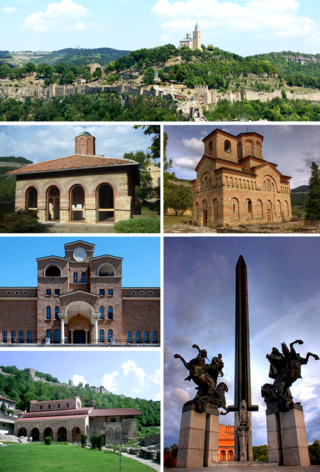
Veliko Tarnovo is a city in north central Bulgaria and the administrative centre of Veliko Tarnovo Province. It is the historical and cultural capital of Bulgaria.

Konstantin Josef Jireček was an Austro-Hungarian Czech historian, politician, diplomat, and Slavist. He was the founder of Bohemian Balkanology and Byzantine studies, and wrote extensively on Bulgarian and Serbian history. Jireček was also a minister in the government of the Principality of Bulgaria for a couple of years.

The Bulgarian Orthodox Church, legally the Patriarchate of Bulgaria, is an autocephalous Eastern Orthodox jurisdiction based in Bulgaria. It is the oldest Slavic Orthodox church, with some 6 million members in Bulgaria and between 1.5 and 2 million members in a number of other European countries, Asia, the Americas, Australia, and New Zealand. It was recognized as autocephalous in 1945 by the Ecumenical Patriarchate of Constantinople.

Nikopol is a town in northern Bulgaria, the administrative center of Nikopol Municipality, part of Pleven Province, on the right bank of the Danube river, 4 kilometres downstream from the Danube’s confluence with the Osam river. It spreads at the foot of steep chalk cliffs along the Danube and up a narrow valley.

Shumen is the tenth largest city in Bulgaria and the administrative and economic capital of Shumen Province.
Ivan Sratsimir, or Ivan Stratsimir, was emperor (tsar) of Bulgaria in Vidin from 1356 to 1396. He was born in 1324 or 1325, and he died in or after 1397. Despite being the eldest surviving son of Ivan Alexander, Ivan Sratsimir was disinherited in favour of his half-brother Ivan Shishman and proclaimed himself emperor in Vidin. When the Hungarians attacked and occupied his domains, he received assistance from his father and the invaders were driven away.

Ivan Shishman ruled as emperor (tsar) of Bulgaria in Tarnovo from 1371 to 3 June 1395. The authority of Ivan Shishman was limited to the central parts of the Bulgarian Empire.
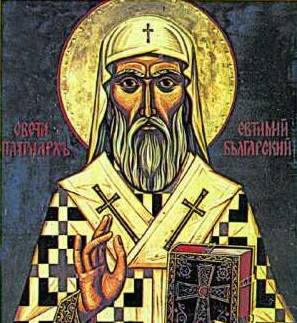
Saint Euthymius of Tarnovo was Patriarch of Bulgaria between 1375 and 1393. Regarded as one of the most important figures of medieval Bulgaria, Euthymius was the last head of the Bulgarian Orthodox Church in the Second Bulgarian Empire. Arguably the best esteemed of all Bulgarian patriarchs, Euthymius was a supporter of hesychasm and an authoritative figure in the Eastern Orthodox world of the time.
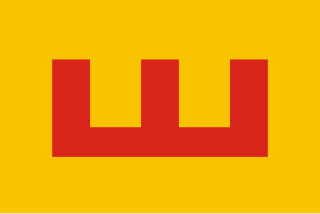
The Second Bulgarian Empire was a medieval Bulgarian state that existed between 1185 and 1396. A successor to the First Bulgarian Empire, it reached the peak of its power under Tsars Kaloyan and Ivan Asen II before gradually being conquered by the Ottomans in the late 14th century.
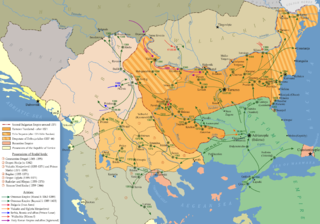
The history of Ottoman Bulgaria spans nearly 500 years, from the conquest by the Ottoman Empire of the smaller kingdoms emerging from the disintegrating Second Bulgarian Empire in the late 14th century, to the Liberation of Bulgaria in 1878. As a result of the Russo-Turkish War (1877–1878), the Principality of Bulgaria, a self-governing Ottoman vassal state that was functionally independent, was created. In 1885 the Ottoman autonomous province of Eastern Rumelia came under the control of and was unified with the Principality of Bulgaria. Bulgaria declared independence in 1908.
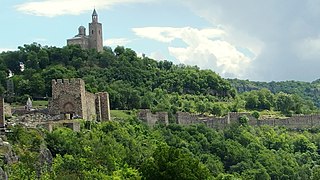
Tsarevets is a medieval stronghold located on a hill with the same name in Veliko Tarnovo in northern Bulgaria. Tsarevets is 206 metres (676 ft) above sea level. It served as the Second Bulgarian Empire's primary fortress and strongest bulwark between 1185 and 1393, housing the royal and the patriarchal palaces, and it is also a popular tourist attraction.

The Bulgarian–Ottoman wars were fought between the kingdoms remaining from the disintegrating Second Bulgarian Empire, and the Ottoman Empire, in the second half of the 14th century. The wars resulted with the collapse and subordination of the Bulgarian Empire, and effectively came to an end with the Ottoman conquest of Tarnovo in July 1393, although other Bulgarian states held out slightly longer, such as the Tsardom of Vidin until 1396 and the Despotate of Dobruja until 1411. As a result of the wars the Ottoman Empire greatly expanded its territory on the Balkan peninsula, stretching from the Danube to the Aegean Sea.

The Architecture of the Tarnovo Artistic School is a term for the development of architecture during the Second Bulgarian Empire (1185–1396). In the 13th and 14th centuries the capital Tarnovo determined the progress of the Bulgarian architecture with many edifices preserved or reconstructed which show the skills of the Medieval Bulgarian architects and the construction and decorative techniques they used. The builders have created a unique architectural style, known as Tarnovian Style, that influenced the architecture in many countries of Southeastern Europe and parts of Central Europe. With its diverse architecture, the Tarnovo School may be separated into several branches according to the function of the buildings.

The Church of Saints Peter and Paul is a medieval Bulgarian Orthodox church in the city of Veliko Tarnovo in central northern Bulgaria, the former capital of the Second Bulgarian Empire. The 13th-century church lies at the foot of the Tsarevets hill's northern slopes and was reconstructed in 1981.
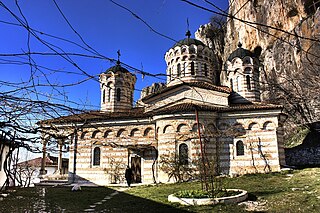
The Patriarchal Monastery of the Holy Trinity is a Bulgarian Orthodox monastery in the vicinity of Veliko Tarnovo, north central Bulgaria. Founded in the Middle Ages, it was reconstructed in 1847 and again in the mid-20th century.
Ivan Asen II, also known as John Asen II, was Emperor (Tsar) of Bulgaria from 1218 to 1241. He was still a child when his father Ivan Asen I – one of the founders of the Second Bulgarian Empire – was killed in 1196. His supporters tried to secure the throne for him after his uncle, Kaloyan, was murdered in 1207, but Kaloyan's other nephew, Boril, overcame them. Ivan Asen fled from Bulgaria and settled in the Rus' principalities.

The Patriarchal Cathedral of the Holy Ascension of the Lord is a former Eastern Orthodox cathedral in the city of Veliko Tarnovo, in north central Bulgaria. Located on top of the fortified Tsarevets hill in the former capital of the Second Bulgarian Empire, the cathedral was the seat of the Bulgarian patriarch from its construction in the 11th–12th century to its destruction in 1393.
This is a list of people, places, and events related to the medieval Bulgarian Empires — the First Bulgarian Empire (681–1018), and the Second Bulgarian Empire (1185–1396).
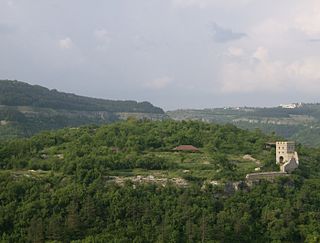
Trapezitsa is a medieval stronghold located on a hill with the same name in Veliko Tarnovo in northern Bulgaria.

Veliko Tarnovo is a city in north central Bulgaria and the administrative centre of Veliko Tarnovo Province. It is also known as Turnovo, Tsarevgrad or Turnov, and is a city with over 7000 years of history.
















